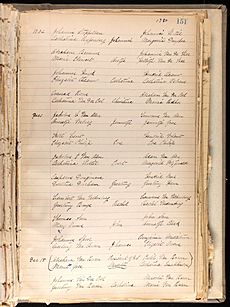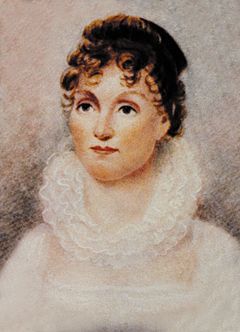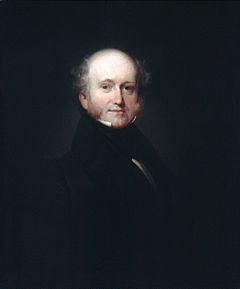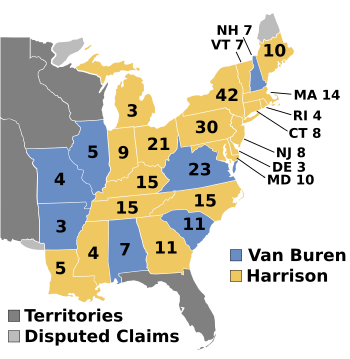Martin Van Buren facts for kids
Quick facts for kids
Martin Van Buren
|
|
|---|---|

Portrait by Mathew Brady, c. 1855–1858
|
|
| 8th President of the United States | |
| In office March 4, 1837 – March 4, 1841 |
|
| Vice President | Richard Mentor Johnson |
| Preceded by | Andrew Jackson |
| Succeeded by | William Henry Harrison |
| 8th Vice President of the United States | |
| In office March 4, 1833 – March 4, 1837 |
|
| President | Andrew Jackson |
| Preceded by | John C. Calhoun |
| Succeeded by | Richard Mentor Johnson |
| 13th United States Minister to the United Kingdom | |
| In office August 8, 1831 – April 4, 1832 |
|
| President | Andrew Jackson |
| Preceded by | Louis McLane |
| Succeeded by | Aaron Vail (acting) |
| 10th United States Secretary of State | |
| In office March 28, 1829 – May 23, 1831 |
|
| President | Andrew Jackson |
| Preceded by | Henry Clay |
| Succeeded by | Edward Livingston |
| 9th Governor of New York | |
| In office January 1, 1829 – March 12, 1829 |
|
| Lieutenant | Enos T. Throop |
| Preceded by | Nathaniel Pitcher |
| Succeeded by | Enos T. Throop |
| United States Senator from New York |
|
| In office March 4, 1821 – December 20, 1828 |
|
| Preceded by | Nathan Sanford |
| Succeeded by | Charles E. Dudley |
| 14th Attorney General of New York | |
| In office February 17, 1815 – July 8, 1819 |
|
| Governor |
|
| Preceded by | Abraham Van Vechten |
| Succeeded by | Thomas J. Oakley |
| Member of the New York Senate from the Middle district |
|
| In office July 1, 1813 – June 30, 1820 |
|
| Preceded by | Edward Philip Livingston |
| Succeeded by | John Miller |
| Surrogate of Columbia County, New York | |
| In office 1808–1813 |
|
| Preceded by | James I. Van Alen |
| Succeeded by | James Vanderpoel |
| Personal details | |
| Born |
Maarten van Buren
December 5, 1782 Kinderhook, New York, U.S. |
| Died | July 24, 1862 (aged 79) Kinderhook, New York, U.S. |
| Resting place | Kinderhook Reformed Church Cemetery |
| Political party |
|
| Spouse | |
| Children | 5, including Abraham II and John |
| Parents |
|
| Relatives | Family of Martin Van Buren |
| Education | Kinderhook Academy Washington Seminary |
| Occupation |
|
| Signature | |
| Nicknames |
|
Martin Van Buren (born Maarten van Buren; December 5, 1782 – July 24, 1862) was an American lawyer and politician. He served as the eighth president of the United States from 1837 to 1841. He was a key founder of the Democratic Party.
Before becoming president, Van Buren held many important jobs. He was New York's attorney general and a U.S. senator. He also served briefly as the ninth governor of New York. Later, he joined Andrew Jackson's team as the Secretary of State and then as the eighth vice president. Van Buren won the presidency in 1836. He lost his re-election bid in 1840. Later in life, he became an important leader against slavery, running for president with the Free Soil Party in 1848.
Van Buren was born in Kinderhook, New York. Most people there were of Dutch descent and spoke Dutch. He was the first president born after the American Revolution. He is also the only president whose first language was not English. He trained as a lawyer and started his political career with the Democratic-Republican Party.
After the 1824 election, Van Buren wanted to bring back a strong two-party system. He supported Andrew Jackson for president in 1828. He became governor of New York to help Jackson's campaign. He then resigned to become Jackson's Secretary of State. In this role, Van Buren helped build the Democratic Party. He later became Jackson's vice president.
With Jackson's support, Van Buren won the 1836 presidential election. However, his popularity dropped because of his handling of the Panic of 1837, a major economic crisis. His plan was to create an Independent Treasury system. This system would store government money in vaults instead of banks. His presidency also faced the costly Second Seminole War. He also refused to admit Texas as a slave state to avoid more arguments about slavery. In 1840, he lost his re-election to William Henry Harrison.
Van Buren was a top candidate for the Democratic nomination in 1844. But he was against adding Texas to the U.S. This angered Southern Democrats, and James K. Polk was nominated instead. In 1848, Van Buren ran for president with the new Free Soil Party. His campaign helped Zachary Taylor win the election. After 1848, Van Buren rejoined the Democratic Party. He became a strong voice against slavery. He supported President Abraham Lincoln during the American Civil War. He died in Kinderhook, New York, on July 24, 1862, at age 79.
Historians often rank Van Buren as an average or below-average president. This is mainly because of how he handled the Panic of 1837. However, some historians praise him for letting the market recover naturally and avoiding wars.
Contents
Early Life and Education
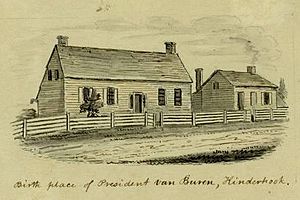
Martin Van Buren was born Maarten Van Buren on December 5, 1782. His birthplace was Kinderhook, New York. This town is about 20 miles south of Albany.
His father, Abraham Van Buren, was a farmer and tavern owner. He was a Patriot during the American Revolution. He later joined the Democratic-Republican Party. Martin's mother was Maria Hoes Van Alen. She was also of Dutch background. Martin was the third of five children from her second marriage.
Van Buren went to the village schoolhouse. He also briefly studied Latin at the Kinderhook Academy and Washington Seminary. He grew up speaking mostly Dutch. He learned English in school, making him the only U.S. president whose first language was not English. He learned a lot about people from different backgrounds at his father's inn. This helped him later in his political career.
His formal schooling ended in 1796. He then began studying law with Peter Silvester and his son Francis. Even though the Silvesters were Federalists, Van Buren followed his father's Democratic-Republican beliefs. He finished his law studies in New York City. He learned about state politics from William P. Van Ness. In 1803, he became a lawyer and returned to Kinderhook.
Van Buren married his childhood sweetheart, Hannah Hoes, on February 21, 1807. She also spoke Dutch as her first language. They had six children, but only four lived to adulthood. Hannah died from tuberculosis in 1819 at age 35. Van Buren never married again.
Early Political Career
After becoming a lawyer, Van Buren focused more on politics. He had been involved in politics since he was 18. In 1801, he helped John Peter Van Ness get a nomination for Congress. Van Buren later became an ally of DeWitt Clinton and Daniel D. Tompkins. In 1807, he was appointed Surrogate of Columbia County, New York. He moved to Hudson in 1808 to further his career.
In 1812, Van Buren was elected to the New York State Senate. Later that year, the U.S. entered the War of 1812 against Great Britain. Van Buren supported President James Madison during the war. His strong support helped him gain influence. In 1815, he was elected New York Attorney General. He moved to Albany, the state capital. He continued to serve as both state senator and attorney general.
The Albany Regency
After the 1816 election, Van Buren became the leader of a group in New York called the "Bucktails". This group was against Governor Clinton. The Bucktails were very good at getting their loyal supporters into government jobs.
Through this system, Van Buren created a powerful political organization. It was known as the "Albany Regency". This group became very important in New York politics. They worked with the Tammany Hall group in New York City. Van Buren helped expand voting rights for white men in New York in 1821. By 1820, Van Buren was the main leader of the state's Democratic-Republicans.
Entering National Politics
In February 1821, Van Buren was elected to represent New York in the United States Senate. He quickly became a well-known figure in Washington, D.C. He was known for researching topics thoroughly before speaking. He served as chairman of important committees, like the Finance Committee. People started calling him "Little Magician" and "Sly Fox" because of his political skills.
In the 1824 presidential election, Van Buren supported William H. Crawford. Crawford believed in Jeffersonian ideas of states' rights and limited government. The election was very close, and no one won a majority of the electoral votes. The decision went to the United States House of Representatives. John Quincy Adams won the election with the help of Henry Clay.
After the 1824 election, Van Buren focused on the next election in 1828. He wanted to bring back a two-party system based on different ideas, not just personalities. He decided that Andrew Jackson was the best candidate to defeat Adams. Van Buren worked to unite Crawford's former supporters behind Jackson. He also formed alliances with other politicians who opposed Adams.
1828 Elections and Governorship
Van Buren helped pass the Tariff of 1828. This tariff helped some industries but angered Southern states. He believed that the South would not support Adams, and New England would not support Jackson. So, he was willing to upset both regions with the tariff.
In 1828, Van Buren decided to run for Governor of New York. He wanted to help Jackson's presidential campaign. He won the election and became governor on January 1, 1829. His time as governor was short, only 43 days. But he did pass a law to protect bank deposits. He also appointed key supporters to state jobs. Nationally, Jackson defeated Adams by a large margin.
Jackson Administration (1829–1837)
Secretary of State
In February 1829, Jackson asked Van Buren to be his Secretary of State. Van Buren accepted and resigned as governor. During his time as Secretary of State, Van Buren had several successes. He settled claims against France from the Napoleonic Wars. He also opened trade with the British West Indies and made a treaty with the Ottoman Empire.
Van Buren became a key advisor to Jackson on important issues. He helped convince Jackson to veto the Maysville Road bill. This veto supported the idea of limited government. Van Buren also became involved in a disagreement with Vice President John C. Calhoun. This disagreement was partly due to the "Petticoat affair". This was a social scandal involving the wife of Secretary of War John H. Eaton.
The other cabinet wives, led by Calhoun's wife, refused to socialize with Mrs. Eaton. As a widower, Van Buren was not affected by this. He tried to fix the problem, but it continued. Jackson believed the issues against Eaton were part of a plot against his administration. This affair, along with debates over the tariff, caused a split between Jackson and Calhoun. Van Buren became Jackson's likely successor.
To resolve the Petticoat affair, Van Buren offered to resign. In April 1831, Jackson accepted and reorganized his cabinet. This removed Calhoun's allies from the administration. Van Buren continued to advise Jackson as part of his "Kitchen Cabinet" (an informal group of advisors).
Ambassador to Britain and Vice Presidency
In August 1831, Jackson appointed Van Buren as the ambassador to Britain. He arrived in London in September. However, in February 1832, the Senate rejected his appointment. This was mainly due to Calhoun's efforts. Calhoun thought this would end Van Buren's career.
But Calhoun's plan backfired. By making Van Buren seem like a victim, Calhoun actually made Van Buren more popular with Jackson and the Democratic Party. Jackson then arranged for Van Buren to be nominated for vice president. In May 1832, Van Buren was nominated as Jackson's running mate.
When Van Buren returned from Europe, he got involved in the "Bank War". This was a fight over whether to renew the charter of the Second Bank of the United States. Van Buren did not trust banks and supported Jackson's veto of the Bank's charter. The Jackson–Van Buren ticket won the 1832 election by a large margin. Van Buren became vice president in March 1833.
As Vice President, Van Buren remained one of Jackson's closest advisors. He supported Jackson's efforts to remove federal funds from the Bank. During Jackson's second term, Jackson's supporters began calling themselves the Democratic Party. Those who opposed Jackson formed the Whig Party.
Presidential Election of 1836
President Andrew Jackson decided not to run for another term in 1836. But he still had a lot of influence in the Democratic Party. Jackson wanted Van Buren to be elected to continue his policies. With Jackson's strong support, Van Buren easily won the Democratic nomination for president.
Van Buren's opponents in the 1836 election were from the Whig Party. The Whigs were a loose group united by their opposition to Jackson's policies. They ran several candidates, hoping to prevent anyone from winning a majority of electoral votes. This would send the election to the House of Representatives.
Van Buren worked to get support from Southern voters. He told them he was against abolitionism (ending slavery) and supported keeping slavery where it already existed. He even cast a tie-breaking Senate vote to stop abolitionist mail in the South. Van Buren believed slavery was wrong but allowed by the Constitution.
Van Buren won the election with 50.9% of the popular vote and 170 electoral votes. His victory was due to his own skills, Jackson's popularity, the strong Democratic Party, and the Whigs' inability to unite. This election was important because it helped establish the Second Party System in American politics.
Presidency (1837–1841)
| The Van Buren Cabinet | ||
|---|---|---|
| Office | Name | Term |
| President | Martin Van Buren | 1837–1841 |
| Vice President | Richard Mentor Johnson | 1837–1841 |
| Secretary of State | John Forsyth | 1837–1841 |
| Secretary of Treasury | Levi Woodbury | 1837–1841 |
| Secretary of War | Joel Roberts Poinsett | 1837–1841 |
| Attorney General | Benjamin Franklin Butler | 1837–1838 |
| Felix Grundy | 1838–1840 | |
| Henry D. Gilpin | 1840–1841 | |
| Postmaster General | Amos Kendall | 1837–1840 |
| John Milton Niles | 1840–1841 | |
| Secretary of the Navy | Mahlon Dickerson | 1837–1838 |
| James Kirke Paulding | 1838–1841 | |
Van Buren kept most of Jackson's cabinet members. He hoped this would show that he would continue Jackson's policies. His cabinet included people from different parts of the country. Van Buren held regular cabinet meetings. He listened to advice from his department heads. He saw himself as a mediator between different opinions.
The Panic of 1837
Just two months after Van Buren became president, a major economic crisis hit. On May 10, 1837, banks in New York stopped exchanging paper money for gold or silver. This quickly spread across the country. This event became known as the Panic of 1837. It led to a five-year depression. Banks failed, and many people lost their jobs.
Van Buren blamed the crisis on greedy businesses and banks. Whigs blamed Jackson's economic policies, especially his "Specie Circular." This order required land to be bought with gold or silver. Many believed Jackson's actions against the Second Bank of the United States also caused the panic. The economic downturn hurt the Democratic Party in elections.
To fix the crisis, Whigs wanted to bring back a national bank. Van Buren proposed an Independent Treasury system. Under this plan, the government would keep its money in gold or silver in its own vaults. This would separate the government from private banks. This plan was meant to prevent inflation. An alliance of conservative Democrats and Whigs delayed the plan until 1840. The depression greatly affected Van Buren's chances for re-election.
Indian Removal Policy
Under Jackson, the government had a policy to move Native American tribes west of the Mississippi River. This was done through the Indian Removal Act of 1830. During Van Buren's presidency, 19 treaties were signed with tribes. In 1838, Van Buren ordered General Winfield Scott to forcibly move the Cherokee people. This was based on the 1835 Treaty of New Echota.
About 20,000 Cherokee people were forced from their homes. They were held in camps and then moved west. This difficult journey became known as the Trail of Tears. Many people died along the way. Famous writer Ralph Waldo Emerson wrote to Van Buren to protest this treatment.
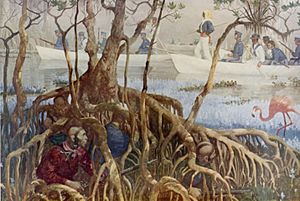
Van Buren's administration also faced conflict with the Seminole Indians in Florida. This was called the Second Seminole War. General Thomas Jesup was in charge of forcing the Seminoles to move west. Many Seminoles surrendered, but some escaped.
In December 1837, Jesup launched a major attack. The war became a long, difficult struggle. The government realized it was hard to remove all Seminoles from Florida. Van Buren sent General Alexander Macomb to negotiate peace. An agreement was made for Seminoles to stay in southwest Florida. But the peace did not last, and the war continued until 1842.
Texas Annexation
Just before Van Buren took office, Andrew Jackson recognized the Republic of Texas. Texas had won independence from Mexico. Jackson hinted at quickly adding Texas to the U.S. This raised fears of war with Mexico and increased tensions over slavery. Abolitionists in the North worried about adding another slave state. Southern leaders wanted more slave territory.
Van Buren chose a different path. He wanted peace abroad and harmony at home. He sought a diplomatic solution to financial disputes with Mexico. When Texas asked to join the U.S. in 1837, Van Buren refused. He cited constitutional concerns and fear of war with Mexico. He also worried about sparking more arguments over slavery. Northern and Southern Democrats had an unspoken rule: Northerners would help stop anti-slavery proposals, and Southerners would not push for Texas annexation. Texas withdrew its offer in 1838.
Relations with Great Britain
Canadians in Lower Canada and Upper Canada rebelled against British rule in 1837-1838. Many rebels fled to New York. Rebel leader William Lyon Mackenzie recruited volunteers in Buffalo. They planned to invade Canada from Navy Island. British forces crossed into U.S. territory and burned the American steamboat Caroline that was supplying the rebels. One American was killed.
Many Americans wanted war with Britain. But Van Buren wanted to avoid war. He sent General Winfield Scott to the Canada–United States border. Scott told Americans to seek peaceful solutions. He made it clear the U.S. government would not support attacks on the British. In January 1838, Van Buren declared U.S. neutrality in the Canadian conflict. Congress supported this with a neutrality law.
Another crisis arose in late 1838 in the disputed territory between Maine and New Brunswick. Both Americans and British Canadians were cutting timber there. Tensions grew, and both sides arrested each other's citizens. It almost led to war. Van Buren did not want war over this land. He met with the British minister and agreed to solve the issue through diplomacy. He also sent General Scott to calm tensions. The border dispute was finally settled in 1842.
Amistad Case
The Amistad case was a famous legal battle. It involved a rebellion by Africans on a Spanish slave ship called La Amistad in 1839. Van Buren saw abolitionism as a threat to national unity. He did not want to interfere with slavery where it already existed. His administration supported Spain's demand that the ship and the Africans be returned to them.
A federal court ruled that the Africans were free and should go home. But Van Buren's administration appealed the case to the Supreme Court. In February 1840, former president John Quincy Adams argued for the Africans' freedom. In March 1841, the Supreme Court ruled that the Amistad Africans were free. This case brought attention to the horrors of slavery. It also increased support for the growing abolition movement in the North.
White House Hostess
For the first part of his presidency, Van Buren was a widower. He did not have a specific person to act as White House hostess. When his eldest son Abraham Van Buren married Angelica Singleton in 1838, she became his hostess. She sought advice from Dolley Madison, a former First Lady. Soon, the president's parties became more lively.
However, the nation was in a deep economic depression. Angelica's fancy entertaining style was criticized. Some newspapers claimed she wanted to make the White House grounds look like European royal gardens. A Whig Congressman used this to attack Van Buren. He said the president was living a royal lifestyle. This attack contributed to Van Buren's defeat for re-election.
Presidential Election of 1840
Van Buren easily won the Democratic nomination for a second term in 1840. But he and his party faced a tough election. The U.S. economy was still in a severe downturn. Other issues like slavery and tensions with Britain also caused problems.
The Whigs nominated William Henry Harrison for president. Harrison was famous for his military leadership. For vice president, the Whigs nominated John Tyler of Virginia. The Whigs presented Harrison as a man of the people. They said Van Buren was an aristocrat living a fancy life in the White House. They used slogans like "Van, Van, is a used-up man" and "Martin Van Ruin."
The Whigs also criticized Jackson and Van Buren for overusing their power. They called for a national bank and higher tariffs. The economic crisis made it very hard for Van Buren to win. Harrison won the election by a large margin. An amazing 80% of eligible voters participated. Van Buren actually got more votes than in 1836. But the Whigs brought out many new voters, leading to their victory. The Whigs also won majorities in both the House and Senate.
Post-Presidency (1841–1862)
After his term ended, Van Buren returned to his estate, Lindenwald, in Kinderhook. He continued to follow politics closely. He considered running for president again. He traveled to the Southern and Western United States, meeting with Andrew Jackson and others.
President John Tyler wanted to add Texas to the U.S. Many Democrats, especially in the South, supported this. Van Buren had hoped to avoid taking a public stance on Texas. But as the issue became central to U.S. politics, he spoke out. He believed that adding Texas would lead to an unfair war with Mexico. He published a letter stating his opposition to immediate annexation.
Van Buren's stance against annexing Texas cost him support from many pro-slavery Democrats. At the 1844 Democratic National Convention, Van Buren could not get the two-thirds vote needed for the nomination. James K. Polk, who favored immediate annexation, won the nomination instead. Van Buren was upset but endorsed Polk for party unity. Polk narrowly won the election.
Election of 1848
After 1844, Van Buren became more opposed to slavery. As the Mexican–American War ended, the debate over slavery in new territories grew. Van Buren published an anti-slavery statement. He argued that Congress had the power to stop slavery in new territories. He believed the Founding Fathers wanted slavery to end eventually.
Many of his supporters urged him to run for president again in 1848. The Democratic Party nominated Lewis Cass, who opposed Congress regulating slavery in territories. In response, Van Buren's supporters formed a new party. At a convention in June 1848, they nominated Van Buren for president.
In August 1848, anti-slavery Democrats, Whigs, and members of the Liberty Party met. They formed the Free Soil Party. They nominated Van Buren for president and Charles Francis Adams as his running mate. Van Buren fully supported the Wilmot Proviso. This proposed law would ban slavery in all territories gained from Mexico.
Van Buren did not win any electoral votes. But he finished second in New York. He took enough votes from Cass to help the Whig nominee, Zachary Taylor, win the state and possibly the election. Nationwide, Van Buren won 10.1% of the popular vote. This was the strongest showing by a third-party presidential candidate up to that time.
Later Life and Death

Van Buren never ran for public office again after 1848. But he continued to follow national politics closely. He was worried about the South wanting to leave the Union. He welcomed the Compromise of 1850. This was a set of laws meant to ease tensions over slavery. He also toured Europe, becoming the first former U.S. president to visit Britain.
Van Buren returned to the Democratic Party. He supported Franklin Pierce in 1852 and James Buchanan in 1856 for president. He opposed the Know Nothing movement and felt the Republican Party made tensions worse. He thought the Supreme Court's ruling in the 1857 Dred Scott v. Sandford case was a "grievous mistake."
After Abraham Lincoln was elected and Southern states left the Union, Van Buren tried to call a constitutional convention. When the American Civil War began, Van Buren publicly supported the Union.
Van Buren's health declined in 1861. He died of bronchial asthma and heart failure at his Lindenwald estate on July 24, 1862. He was 79 years old. He is buried in the Kinderhook Reformed Dutch Church Cemetery. Van Buren outlived four presidents who came after him: Harrison, Tyler, Polk, and Taylor. He lived to see Abraham Lincoln become the 16th President.
Legacy and Reputation

Van Buren's most lasting achievement was his skill as a political organizer. He helped build the Democratic Party into a powerful force. Historians see him as very important to the development of the American political system.
However, his presidency is often seen as average. He was blamed for the Panic of 1837 and lost his re-election. His time in office was dominated by the economic crisis. Some historians disagree with this negative view. They argue that Van Buren allowed the market to recover quickly. He also reduced government spending and avoided wars.
Memorials
Van Buren's home in Kinderhook, New York, called Lindenwald, is now the Martin Van Buren National Historic Site. Several counties in Michigan, Iowa, Arkansas, and Tennessee are named after him. There is also Mount Van Buren, a U.S. Navy ship, three state parks, and many towns named in his honor.
In Popular Culture
Books
In Gore Vidal's 1973 novel Burr, there is a story about trying to stop Van Buren from becoming president. This is done by trying to prove he is the secret son of Aaron Burr.
Cartoons
In the comic strip Doonesbury, artist Garry Trudeau showed characters trying to rob Van Buren's grave. This was part of a ritual to help George H. W. Bush win the 1988 presidential election.
Currency
Martin Van Buren appeared on the Presidential dollar coins series in 2008. The U.S. Mint also released commemorative silver medals for him in 2021.
Film and TV
Nigel Hawthorne played Van Buren in the 1997 film Amistad. The movie shows the legal fight over the enslaved Africans on the La Amistad ship.
On the TV show Seinfeld, an episode called "The Van Buren Boys" is about a fictional street gang. This gang admires Van Buren and uses symbols based on him, like an eight-finger hand sign.
In an episode of The Monkees, "Dance, Monkee, Dance," a dance studio offers free lessons for answering a question. The question is: "Who was the eighth President of the United States?" Martin Van Buren, played by Stephen Coit, appears to claim the prize.
Music
At least two bands have used Van Buren in their names: The Van Buren Boys from Illinois and The Van Burens from Massachusetts.
See also
 In Spanish: Martin Van Buren para niños
In Spanish: Martin Van Buren para niños
- American election campaigns in the 19th century
- 1836 United States presidential election
- 1840 United States presidential election
- The Panic of 1837
- List of presidents of the United States
- Andrew Jackson, President when Van Buren was Vice President


